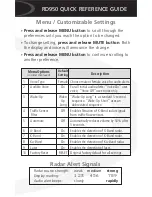
Noise Reduction Techniques
2-7
3.2
Sources of Noise
Some interference is due to geographic location. This interference does not need to be eliminated
since it is possible for the vehicle to be moved away from the interfering noise source. Noise from
power lines, fluorescent lights, and other vehicles (emitting high levels of radiated noise) are
examples of noise which depends upon location. Make certain that you are not attempting to
suppress noise in a vehicle while it is in a noisy location. If you suspect that your location is noisy,
simply turn off everything in the vehicle except the radio and listen to the remaining ambient noise. If
the noise level is objectionable, you may have to noise suppress the vehicle during a less noisy time
of day or in a different, quieter location.
Check the installed radio for conducted and inducted noise by using an unmodulated signal
generator to supply a clean RF signal through a coaxial cable directly to the antenna connector on
the radio set. This should prevent radiated noise from entering the receiver and masking conducted
and induced noise. Make certain that the signal generator is not microphonic and is placed away
from the noise of the engine and exhaust.
Operate the controls for fans, blowers, power windows, headlamps, turn signals, windshield wipers,
and other electrical accessories. Listen for the presence of noise in the received radio signal. This
will allow the source of the interference to be determined. Some noise sources cannot be turned on
and off at will. These sources will need to be attacked piecemeal on a trial and error basis: alternator
whine, voltage regulators, electric fuel pump, and other possible sources. Remember that induced
noise can result from radio wiring being too close to other vehicle wiring. This problem is most easily
solved by proper cable routing at the time of installation.
Radiated noise must be attacked after conducted and induced noise has been satisfactorily
suppressed. The vehicle ignition system is usually the primary source of this interference. Antenna
placement can be critical in some installations. Remember that static discharge generates static or
radiated noise and will probably be generated only when the vehicle is in motion.
Since radiated noise interference is most noticeable in weak signal areas, it is suggested that
suppression be finalized while listening to a weak “on frequency” signal. (The squelch should be
“open” so that even marginal signals can be heard.)
4.0
Noise Reduction Techniques
4.1
General
There are three basic ways to suppress noise. The first is the addition of resistance in circuits
subject to ringing. This method is used for the ignition coil HV cable, spark plug wires, and spark
plugs. The second is to filter noise from low voltage wiring using coaxial bypass capacitors. The third
is to control static charge build-up using wipers for movable parts such as automobile hoods and
trunk lids, or flexible bonding leads for fixed members. Static in wheels may also be controlled using
collector rings. Applications of each of these techniques are discussed below.
The vehicle manufacturer’s service manual also may provide noise suppression information which is
valuable in any first attempt at noise suppression.






































